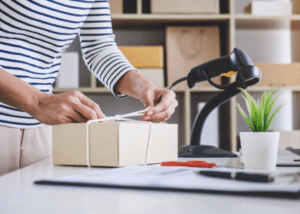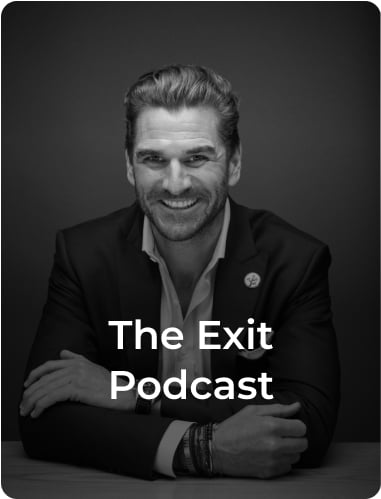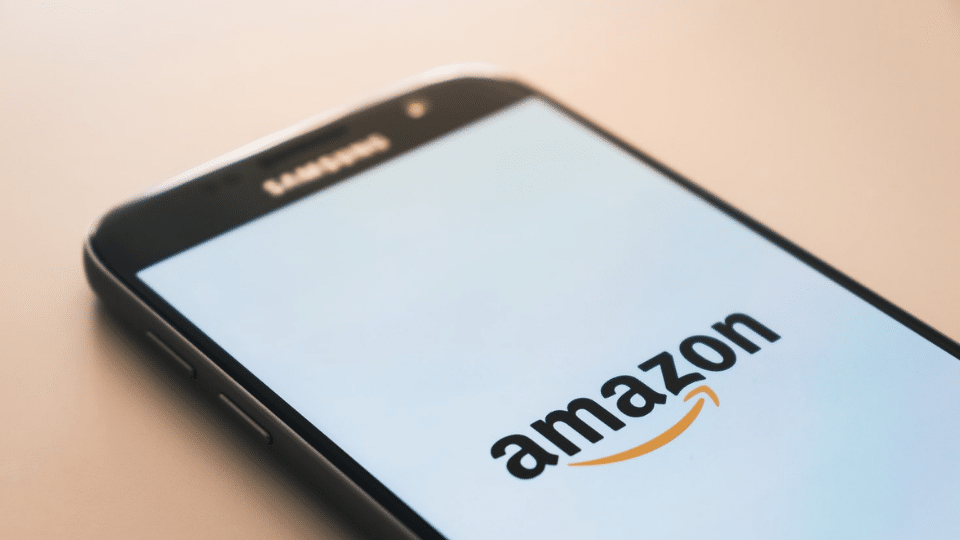
If you research different ways to make money online, one of the first suggestions you will find is operating an Amazon FBA business. An Amazon FBA business can be very lucrative, but it is not a get-rich-quick scheme. There are several things you need to know and do if you want to find success with this online business opportunity. In this guide, you will learn how to start an Amazon FBA business from scratch and make it profitable.
But before your start perhaps you want to consider Buying an Amazon FBA Business? You can enter the Amazon FBA industry with someone having done the hard work of starting an FBA business for you! Read our Guide to Buying an Amazon FBA Business and decide what the right option is for you.
If you still want to start an Amazon FBA business from scratch, keep reading!
What is Amazon FBA?
FBA stands for Fulfillment by Amazon. Amazon FBA is a service offered by the Ecommerce giant as a means for third-party sellers to store their products in Amazon’s fulfillment centers, so the company picks, sorts, packs, ships, tracks, and handles returns and refunds. An Amazon FBA business is where you, as the business owner, choose what products you want to offer, find suppliers, purchase and stock them, and send them out to buyers.
In Amazon’s terms, “you ship it, and we ship it!” Launched way back in 2006, Amazon FBA has become a popular trend in the Ecommerce world today as it allows vendors to shift the burden of managing inventory, shipping every single order, and overseeing customer processes to Amazon so they can concentrate on scaling their business and reaching more customers.
Fulfillment by Amazon (FBA) is one of the two core fulfillment options provided by Amazon, with the other being Fulfillment by Merchant. In FBM, Ecommerce businesses sell directly to customers. An FBM seller is responsible for just about every aspect of the business, and this includes: storage, creating listings, and then, after a sale is made, picking, packing, and shipping directly to the customer.
If a customer wants to make a return or an exchange, the FBM seller will have to directly handle the return and refund. In other words, FBM sellers only use Amazon as a place to reach customers and generate demand since they do everything. Also, sellers must be in top form every day, including weekends and holidays.
Amazon’s sales continue to grow year on year so if you want to get a piece of the very large pie, now is the time. Below you can see the annual net sales revenue of Amazon from 2004 to 2021.
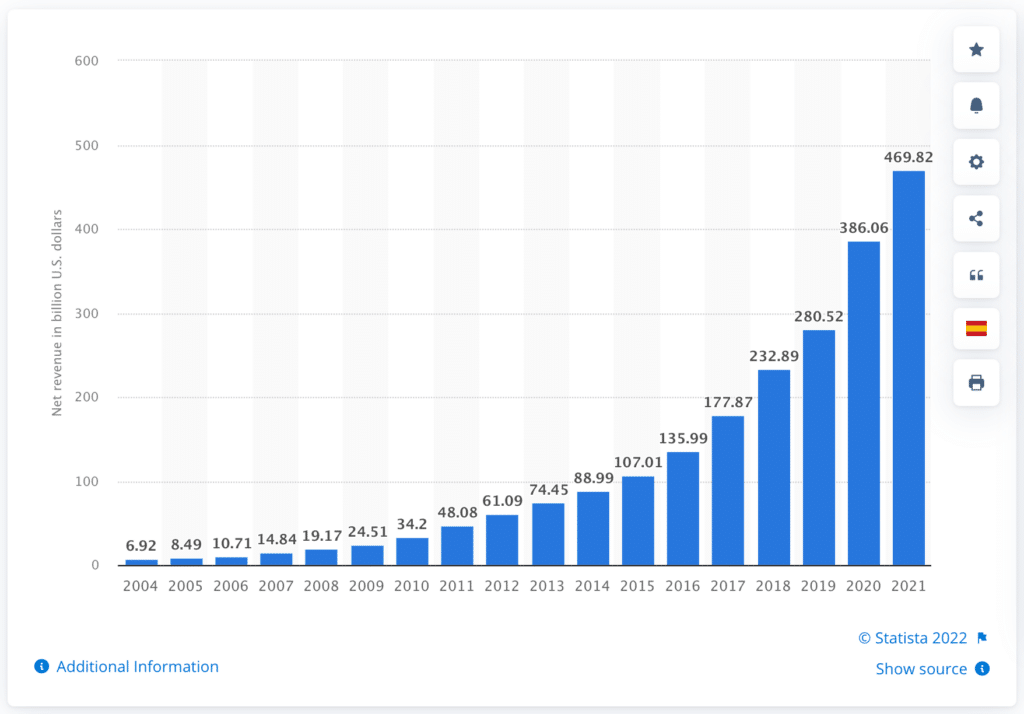
How does Amazon FBA work?
The Amazon FBA process is fairly straightforward, so you don’t need to put a lot of effort into it. Let’s break the process into steps.
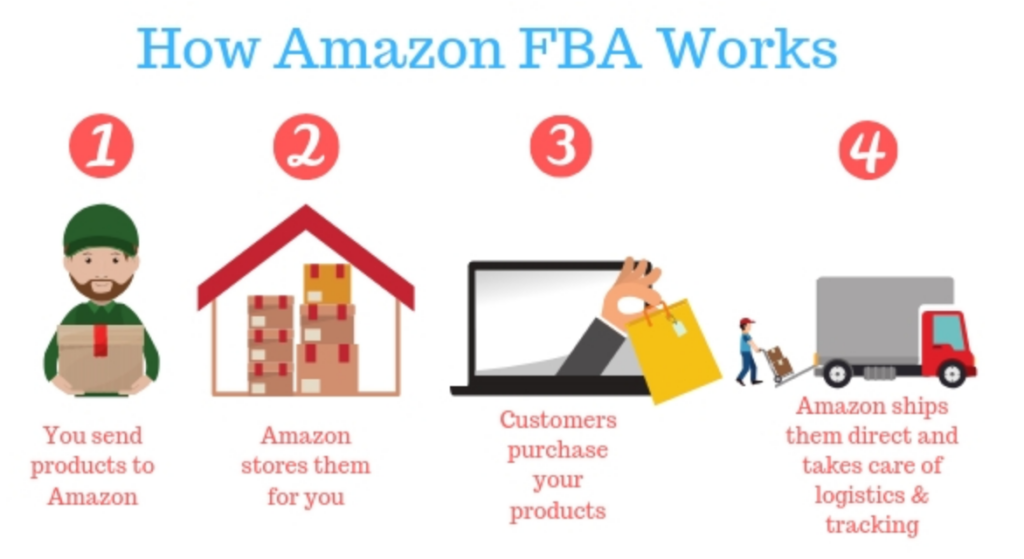
Step 1: List and label your products
Amazon requires that you list all your products on their website. There are three major ways to do this. You either add the products individually to Amazon’s catalog or add them as a group. Alternatively, you can integrate your inventory management software with Amazon’s API. You will also have to choose between labelling your products or using Amazon’s FBA Label Service.
Step 2: Send your products to Amazon’s warehouses
Once you’ve added your products, it’s time to hand them over to Amazon to take care of the rest of the process. When you contact Amazon, they will provide the address of the warehouse you should send the products to. You can ship the inventory with Amazon or with a courier of your choice.
Step 3: Amazon stores the products
Upon receiving your inventory, Amazon will scan the labels, weigh and measure the products and store everything accordingly. When this is done, you will receive a confirmation email, and you can monitor your inventory through their tracking system.
Step 4: Amazon processes all orders
When a customer purchases your products, Amazon takes care of receiving orders and processing them. Amazon’s team will pick the products from inventory, pack and ship the order. The team will also track the order to the customer’s doorstep and provide customers with the tracking information.
Step 5: Amazon handles returns and refunds
If there are any return and refunds claims, Amazon handles them too! You will, of course, be notified of the same.
Step 6: You get paid
Amazon deposits your total earnings into your linked bank account every two weeks.
Also, keep in mind that the FBA service isn’t free as Amazon charges a fee for the service it renders. Nonetheless, the overall fees are significantly lower when you try to manage everything on your own. Also, Amazon states that they will be responsible for any damage to your products while in their warehouses, which means you don’t have to worry about mishandling or losses due to damage.
How to Start an Amazon FBA
Without further ado, let’s dive into details of how you can start your Amazon FBA business.
1. Choose a niche
The first thing you want to do when starting an Amazon FBA business is to choose a niche. A niche simply refers to the focused segment of a broad marketplace. You can refer to it as a submarket if you will.
Choosing a niche can be beneficial to your business in that it provides you with insight into your target audience and its unique demands, thus giving you a competitive advantage compared to sellers trying to reach a broad market.
Finding the niche that’s right for you can be a daunting task, but with the right approach, you can identify the particular segment of the market that will help you maximize profit. Here are some tips to guide you on discovering the perfect niche for your Amazon FBA business.
It should have a good product margin: The overall reason for starting an Amazon FBA business is to make a profit, so you want to do research to see the margins you stand to make on a niche before you commit to selling on Amazon.
Avoid highly seasonal products: Try to avoid products that don’t suffer from seasonality, as this will ensure that you have a steady sales volume throughout the year. Consider hunting for products that are timeless and inconsistent with demand all the time.
Do keyword research: If you’re struggling to get specific enough, let keywords help you. Keywords refer to specific words and phrases which shoppers use to search for products they wish to buy. You can find help in researching keywords by using tools like Google Adwords.
Look for product competitors without video: Videos are a crucial factor when it comes to product rankings. Product categories with a few videos are an incredible option to consider as you have the potential to rank higher than your competitors.
Consider what an ideal product looks like: The dimensions of the product matter too. A large and heavy product is a bad idea unless you already have a good delivery network in place. Products that are small and light are generally easier and cheaper to ship.
There should be good demand for it: Many new sellers often miss this crucial point. Your goal should be to find products that people actually want and not to list products that you think they will want. Research to find categories that generate regular orders.
The tips above are some of the freeways to find the right niche for your business but if you’re not afraid to spend money to make money, consider using an Amazon niche finder tool.
2. Find products – how to find products, assess your competition
If you followed the tips above, you should have no trouble identifying profitable niches for your business. Now you need to find the exact products
Don’t compete with Amazon: This is an underrated piece of advice, but you will save yourself from a lot of trouble by avoiding products that Amazon sells. They will outprice you, and they almost always have the Buy Box.
Avoid products sold by big brands: Amazon isn’t the only big brand you have to worry about. Popular brands can be tough to compete with as the only way to beat them is to have a product that’s pretty revolutionary.
Review best sellers page: If you want to have a really good idea of the products that are in consistent demand, check Amazon’s best sellers page. This page lists the top 100 sellers in a category, allowing you to gauge the popularity of each product and determine if they will be worthwhile.
Identify products that can become private labels: Look for profitable items that you can put your own spin on, and then let Amazon take care of the rest for you using the FBA service. The idea is to spot a top-performing product that you can brand and put back to the market.
Assess your competition: Once you have found a product that’s highly in demand, you want to see how much competition there is. Simply search for the product you want to sell and see what comes up. From the search results, you should be able to see the movers and shakers in that category. Here’s how to analyze the competition:
Identify the keywords they rank for.
Audit your competitor’s product listing by paying attention to what they did in the areas like product title, features, description, Q & A, images, etc.
Check the reviews to see what they like and their pain points for those items.
Monitor their pricing to see whether they sell products at a consistent price or whether they change the prices. A price tracking software (like Sellics) can help you monitor your competitor’s product prices 24/7.
Track their monthly sales to have a solid idea of how many products they sell and how much profit they’re making. Tools like Sellics Edition Software and Jungle Scout‘s Amazon Sales Estimator Tool.
Investigate their marketing strategy by checking their on-Amazon and off-Amazon efforts. Notice the type of content they use, how they communicate with prospective buyers, their social media pages as well as emails and blogs.
Competitive products are great items to sell as the possibility of hitting a goldmine is high. However, you need to also do your due diligence before you start selling. It’s vital to analyze the competition as this may help you discover a competitive advantage to leverage on.
3. Source manufacturers and suppliers
Now that you have found your winning product, it’s time to source manufacturers and suppliers. The right supplier will help you conquer the marketplace by delivering quality products at reasonable prices that allow you to make a decent profit. A few top places to look for manufacturers and suppliers include:
Google has always been a lifesaver when it comes to searching for things, and you just may be able to find a manufacturer and supplier for your desired product. A simple internet search will bring up thousands of results to find the right suppliers.
Trade shows
Attending a trade show can help you meet face-to-face with suppliers. There are usually many manufacturers and suppliers in attendance, so there’s a good chance that you will leave the event with a variety of choices to consider. Plus, you don’t have to set an appointment and wait for days because the manufacturers and suppliers are on the ground also to meet with business owners like yourself.
Online marketplaces
There are plenty of online marketplaces where you can find manufacturers and suppliers for your products. Platforms like Alibaba and Aliexpress are great places to look too. You can also explore wholesale directories like WooCommerce, Spocket, Doba, Wholesale 2B, Salehoo, Worldwide Brands, and more.
Sourcing agencies
A sourcing agency is a company that specializes in finding manufacturers and suppliers for products you want to sell in your country. They’re an excellent way to find reliable suppliers in South Asia or China. These agencies don’t only find but also import the products at a low cost.
Industry associations and publications
Industry associations are groups of people that operate a similar kind of business, which in this instance is Amazon FBA. Mingling with members of these associations might lead to you getting product supplier referrals. Alternatively, search for magazines and blogs that target wholesalers and distributors in your industry, and subscribe to them.
4. Brand your products, establishing your brand and design
Branding your products is an excellent way to stand out from the competition. For starters, you will need to choose two brand names, namely store name, and product name. It’s a good idea to choose a generic store name so you will have no problem adding other products in different niches over time. Also, the product name should be a compelling name that you can potentially trademark.
Your brand logo is an important element because it will be attached to your products, so if you can’t create one yourself, consider hiring a graphic designer. But don’t forget to choose your brand colors and your tagline. When creating your branding design, you want to make sure that it meets some basic criteria that include:
- Simplicity
- Visually appealing
- Contact information
- Request for customers to review your product.
Next, consider enrolling in Amazon Brand Registry, a program that offers verified sellers enhanced access to marketing features and complete control over their brand across Amazon.
To register your brand, you will need a trademark number, images of your brand’s logo, and a list of countries where the products were manufactured and that you plan to distribute them in. The process is straightforward as all you need to do to create a Brand Registry account and enroll your brand.
It takes 2-10 days for the process to be completed, and when your application is approved, you will receive Amazon Standard Identification Numbers (ASINs) for your products so no other seller can list the same items from your page.
5. Creating your seller account
Once you have figured out what you plan on selling, you will need to register to get an Amazon seller account. Before you proceed to create your Amazon seller account, you need to have the necessary paperwork, including:
- Your business information
- Email address
- Credit card
- Phone number
- Tax ID
- State Tax ID
Now, let’s get into the registration process.
Go to https://services.amazon.com
Scroll down the page and click on ‘Sell on Amazon.’ Follow the directions.
Select between ‘Sell as an Individual’ or ‘Sell as a Professional.’ Sign up as a professional if you’re going to sell more than 40 products per month; otherwise, the Individual plan is your best bet. A professional account has a monthly subscription fee of $39.99, but you won’t be charged from the first month. Plus, the plan will also help you save money since it doesn’t come with additional fees.
Enter your email and select ‘Create a New Account.’
Choose your business location and business type.
Enter your personal information
Choose your marketplace (the country) in which you’d like to sell.
Enter your billing information
Provide answers about your products and validate your address.
After setting up your Amazon account, add FBA to your account.
You can now start selling on Amazon!
6. Shipping your Amazon product
Becoming an Amazon FBA seller comes with a lot of benefits, but most newbies struggle with sending their first shipment to the Amazon warehouse. Here’s a simple guide to help you.
Step 1
In the Seller Central dashboard, select ‘Manage FBA Inventory’ from the ‘Inventory’ tab. On the right-hand side, choose the drop-down menu that reads ‘Edit’ and click ‘send/Replenish Inventory.’ If your product is already an FBA listing, all you need to do is click on ‘Send Inventory.’
Step 2
Next, you will be asked to ‘Create a New Shipping Plan.’ Click to proceed and select ‘Case-packed Products,’ which is the option that means you want to send more than one unit of the same product to Amazon. Click on ‘Continue Shipping Plan.’
Step 3
On the next screen, you will be asked to enter the quantity of the products and how many cases you’re shipping. For instance, if you’re planning to ship 20 products in 2 cases, you will need to enter the number 10 into the ‘Units per Case’ box and the number 2 into the ‘Number of Cases’ box. Click to continue.
Step 4
Next, you will need to choose whether or not your products will be prepared before shipping to Amazon. Amazon will let you know what type of prep your type of product requires, but most products are to be packed into an individual polybag with a safety warning. Click continue once your product is correctly prepared.
Step 5
At this point, you will need to label your products. If you’d rather not do this, you can ask Amazon to do it for you, but fees will apply.
Once you’re done with the labeling, it’s time to find out where Amazon wants you to send your inventory. Your account’s default settings are on ‘Distributed Inventory Placement,’ which means Amazon is at liberty to split your inventory, so you send different units to different warehouses. However, you can fix this by changing your FBA shipment settings in Seller Central to send all your units to one warehouse. Go to Settings > Fulfillment by Amazon > Inbound Settings and then edit.
Step 6
In this last step, you will be given an option of courier services – UPS or FedEx, but this is after you have given Amazon the dimensions and weight of your package, which will determine the shipping charges. Click on the checkmark next to ‘I agree to the terms and conditions ‘ and then ‘Accept Charges.’ Lastly, choose the ship date and print your shipping labels. Once you have completed these steps, click ‘Complete Payment.
7. Third party inspection services
Importing products you want to sell so you can ship them to Amazon’s warehouse can be scary because you can’t be too sure of the quality of the products. This is where third-party inspections services come in. Third-party inspection services refer to pre-shipment solutions offered by companies to help sellers ensure that their shipment meets the following requirements:
- That the quantity is as per order
- That the quality matches specifications
- That there are no defects in the products
- That the weight and dimensions of the cartons are per Amazon’s FBA requirements
- That the packaging is as per Amazon’s FBA requirement
- That the labeling is as per Amazon’s FBA requirement
There are many third-party inspection companies out there, and they can help ensure you don’t lose money to fraudulent suppliers. They also help decrease the risk of returns and ensure the quality of the product is top-notch so you can succeed in the marketplace.
8. Launching your products
Before you post your products on Amazon, there are a few things you can do to make the launching a huge success. Here are three tips to help you launch your product and get great results:
Generate a buzz ahead of launch
You may have a great product, but no one will buy it unless they know about it. So you want to do things like write blog posts about the product so buyers can jump in right when it is released. Consider also creating videos for YouTube and social media about the products. Post frequently and make the content interesting.
Optimize your listing
Based on the research of your competitors, you should have a clear idea of how best to list your products for greater visibility. When you’re done, double-check to be sure the title, bullets, and descriptions are keyword-rich. Keep in mind that the goal is to sprinkle keywords in your product detail pages and not to stuff keywords.
What you actually write about your products goes a long way to determine how successful your product will be. So make sure the product description is informative and engaging. Don’t forget to take excellent, hi-res photos from different angles.
You can read more about optimizing your Amazon listing here.
Gather a bunch of product reviews
Most buyers tend to avoid purchasing a new product as they need reviews to help them decide whether or not to buy. In this instance, it’s a good idea to launch the product on your own website so you can garner reviews from respected sources. Post them on your site and share your site to your different social media pages, directing buyers to your Amazon page. From there, you can build reviews for your site.
9. Build your audience
There are many ways to build an audience of raving fans for your Amazon products. The first step is to identify who your target audience is, as this will help you hone your marketing message correctly.
An excellent way to build your audience is to participate in Facebook groups by writing and posting valuable content whenever questions are posed. The idea is to make them know you, like you, and trust you (the KTL factor). You can also create your own group and invite your friends to it while encouraging them to invite others. The idea is to provide valuable content and involve them in the development of new products.
Additionally, you can also explore promotions such as discounts in price, a free gift, free shipping, etc. You can also use the concept of lightning deals and make them available for only a limited time.
10. Amazon Delivery Service Partner
Launched in 2018, Amazon Delivery Service Partner is a program that allows entrepreneurial-minded individuals to start their own delivery business for low startup costs. In other words, the program offers you the opportunity to hitch your entrepreneurial fortunes to one of the fastest-moving companies in the world.
If you become an Amazon delivery service partner, you will operate the business entirely on your own, including setting up, hiring staff, and managing the business. You don’t have to worry if you feel you don’t know much about the business, as Amazon is there to help its DSPs ensure smooth operations via hands-on training to on-demand support.
Set up your Amazon Delivery Service Partners Business Program and Employ Staff
Amazon’s Delivery service Partners (DSP) program is the Ecommerce giant’s attempt to reduce its reliance on United Parcel Service Inc. And the U.S. Postal service. You can set up your Amazon Delivery Service Partners business and join a growing community of DSPs.
You will be required to start up the business, but you don’t have to worry as Amazon offers a variety of deals to acquire the assets you need to start the business. These include discounts on recruiting tools, payroll, tax, accounting software, legal support, and insurance support.
Top Tips for Getting Started with the Amazon Delivery Service Partner Program
If you’re looking to start an Amazon DSP business, here are some key tips:
Be sure you meet the requirements for the business
- Amazon gives five criteria for the DSP program
- Minimum investment of $10,000
- Commitment to fully managing the hiring and development of their teams
- Capable of managing a minimum of 40 vans and 100 employees
- Ensure that shipments are delivered seven days per week throughout the entire year
Fill the online application
You should have no trouble filling the form as the questions are in yes-no format. Amazon essentially wants to know if:
- You have experience hiring and developing teams; You are ready to commit to being a hands-on DSP owner
- You have a strong credit history
- You have owned a business before
- Prepare for the screening process
Amazon wants to know if you qualify to be a DSP. What they’re basically looking for are an up-to-date resume and a clean driving record. They will also run a background check on you, which will include a criminal record check and credit check.
Go for the interview.
The interview is held at one of the company’s fulfillment locations nearest you. Visit this link to know where these locations are. Once you scale through the interview, you can expect an offer and rate card for your business, and you can complete the DSP program.
11. Your Product Listing
Your product listing refers to the product page for each of the items you sell. As you’re probably aware, a typical product page comprises the information you enter when you list your products, including title, images, description, and price. It’s vital to pay attention to your product listing as it not only allows your products to be found but also encourages shoppers to purchase your products.
Here are three things you can do to improve your product listing:
Secure a badge on your product listing
Amazon’s Choice Badges are the company’s way of filtering the best of the best items that shoppers are looking for so they can have peace of mind during the purchase process. To brighten your chances, target keywords you can win because each keyword has a badge attached to it. For example, both ‘hair cutters’ and ‘hair clippers’ have their own Amazon Choice badge attached to them.
Product reviews
If you want Amazon to vouch for your products, you need to generate positive customer reviews. Amazon wants to see that previous buyers are happy with your product and services. Most of your reviews need to be in the four and 5-star categories. If you have negative reviews, go the extra mile with the goal of changing them into positive ones.
Maintain a high seller rating
Your seller rating is a reflection of your customer experience over a period. It is determined by a range of factors, including the return rate, how fast products get to customers, and how quickly you respond to inquiries.
12. Product description
A product description is an essential part of listing as it shows the value of a product to a potential customer. If done correctly, it can positively influence the decision of a customer because it clearly highlights how the product can solve their problem.
Optimize your product description
Want to write a compelling and SEO-friendly product description? Here are some tips:
Strategically sprinkle keywords in the content to increase the chances of shoppers finding the product
Clearly highlight the key features of the product so potential buyers can instantly have an idea of the problem the product solves.
Make the content simple and clear. Use simple words to state what sets the product apart from competing items
Use strong verbs to describe how the product will
Write your product descriptions
Copying product descriptions is a must for every seller that wants to be successful. Always write unique and distinct product descriptions.
13. Private label
A private label is a product that a retailer gets produced by a third party but that it sells under its own brand. Excellent examples include Walmart’s ‘Great Value,’ and Costco’s ‘Kirkland.’ Many Amazon FBA sellers are adopting private labels as their business model because of its lower operating costs, better brand loyalty, higher profit margins, and better brand loyalty.
Identify products that can become private label products
How to find products with the potential to become private label items can be grouped into three steps:
- Search for items that are highly in demand by looking out for products with a low sales rank and highly ranked keywords.
- Next, check out your competition. Narrow your focus items with less than 1,000 reviews to confirm that the market isn’t already saturated.
- Evaluate products that make it to this stage by selecting products that are small and light so you won’t pay heavily for shipping.
Uncover product opportunities and establish your private label
To succeed in the Amazon FBA business using the private label model, you will need to increase your product offerings. To do this, research product ideas, do competitive analysis, study the reviews, and identify ways you can make the product better. Don’t forget to also source for manufacturers and suppliers for the products,
14. Customer Service
Customers get Amazon’s trusted customer service and returns
A major advantage of the Amazon FBA program is that Amazon takes care of customer service and returns for sellers’ orders. Your product listing will be displayed with the Prime logo so customers can have peace of mind from the knowledge that Amazon handles packing, delivery, customer service, and returns.
15. Profit margin
Wondering how you can be sure a product is going to be profitable before you start sourcing it? Use Amazon’s handy FBA profit calculator to figure out the exact profit on the item.
To get started, get the ASIN of any item you’d like to calculate the margin for and enter it into the search product box. Fill in the item price, the cost to ship it to Amazon, and the total cost of the product per unit.
When you hit ‘Calculate,’ the tool will give you a breakdown of your Amazon fulfillment costs. Adjust the number of sellers and estimated sales to calculate the revenue and profit.
16. Costs of Starting an Amazon FBA Business
When it comes to starting any business, many people often wonder how much it would cost to start and grow. Here is an overview of the costs of starting an Amazon FBA business.
Costs of starting an Amazon FBA business
Ongoing costs: Amazon FBA sellers pay a monthly fee of $39.99 for a professional plan to operate their business.
Shipping costs: Amazon charges fees per unit, with the cost including picking and packing your orders, shipping and handling, customer service, and product returns. The fees are calculated on the weights and dimensions of your product.
Below are the costs for FBA Fulfillment for non-apparel items.

Startup costs: The startup cost is up to you as it depends on how much you have budgeted.
Storage costs: Amazon charges monthly storage fees of $0.69 per cubic foot used for January to September and $2.40 for October to December per cubit of storage used. Long-term storage fees (that have exceeded 365 days) attract $6.90 per cubic foot used or $0.15 per unit, whichever is greater.
Marketing costs: Small businesses spend around $9000 to $15,000 for Amazon marketing services, while medium-sized companies spend about $15,000 to $35,000.
Average costs: Depending on your budget, the average cost of starting an Amazon FBA business is around $1,000 to $3,000.
Biggest costs: Perhaps, the biggest cost of selling on Amazon FBA is the sales cost. Also known as the referral costs, this is the fee Amazon charges whenever a sale is made for referring buyers to you. Sales fees range from 6%-%20.
17. Tax
If you’re planning to start selling on Amazon, it’s important to consider issues relating to tax. These are the major questions that new sellers ask.
Do I need a business plan license to sell on Amazon?
The simple answer to this question is ‘No.’ You don’t need to secure a license to sell on Amazon since most of the products and services on the website are not federally regulated. These products are primarily consumer products, and they don’t require government approval.
Do I need to pay taxes if I sell on Amazon?
The short answer is ‘Yes.’ Amazon FBA (and non-FBA) income is taxable. All sellers on Amazon are required to report Amazon sales on their taxes just like other income streams.
Do I need an LLC?
The simple answer is ‘Maybe.’ You don’t really need an LLC to start selling on Amazon unless you wish to do so for a few reasons, which typically border on financial and legal protection. However, you can create a seller account as a sole proprietor as long as you’re a US citizen.
18. Business plan
Much like every other type of business, it helps to have a business plan if you’re looking to start Amazon FBA. You want to stand out from your competitors, and a business plan can help you define the path to get there. Here are some questions you may want to ask about having a business plan for Amazon FBA.
Do I need an Amazon FBA business plan?
A business plan is not one of the requirements for starting an Amazon FBA business, but it’s a good idea to have one, so it serves as the internal road map to implement when starting and growing your business.
Marketing strategy
There are thousands of Amazon FBA sellers and products in the marketplace. If you want to achieve success, you need to figure out how you can get ahead of the competition. Here are some things to put into consideration when developing your marketing strategy.
SWOT analysis: Conduct strengths, weaknesses, opportunities, and threats analysis so you can know how best to market your products.
Customer segments: Identify the specific groups of people that your products target and the factors that matter most to them.
Customer relationship: Develop strategies to build lasting relationships with your target audience.
Elevator pitches and taglines: Create short ways of introducing your products and persuading your audience to buy.
Marketing ideas: Brainstorm things you can do to create awareness about your product and promote it.
Marketing budget: Decide the amount of money you can afford to allocate to marketing
How can I find an existing Amazon FBA business for sale
Amazon FBA sellers put up their businesses for sale for the same reasons brick and mortar brands sell their business. There are many places you can find existing businesses to buy, but the best place to start is Flippa!
Amazon FBA FAQs
How much time do you spend per day/week on running your Amazon business?
It’s up to you to decide how much time you want to spend operating your business. You can choose to run it full-time or part-time. Most sellers spend less than 30 hours per week working on their Amazon businesses.
How to Start an Amazon Business as a Seller?
You can start selling by visiting the Amazon seller sign-up page to create an account. You will be asked to choose your business model and provide basic details about yourself and the products you want to sell.
How Much Does Starting Amazon FBA Cost as a Reseller?
In general, it takes about $500-$2000 to start an Amazon FBA reseller business if the products are relatively inexpensive.
How to Get a Business Loan to Launch Your Amazon Business?
You can get a business loan by applying for one via the Amazon Lending Program. Alternatively, you can opt for the Small Business Administration (SBA) microloan or secure a loan from Fintech lenders like Kabbage and AccrueMe. You can also check out Flippa’s Finance Services here.
Do I Need an Amazon FBA Business Plan?
Unless you’re looking to secure a loan, you don’t need a plan to start your Amazon FBA business. Nonetheless, it’s a good idea to have a business plan as it can help you have a solid idea of how to start and run your business.
How to Find Products to Sell on Amazon FBA?
Finding products to sell on Amazon can be a daunting process, but it helps to know what to do. Top tips include keyword research, product reviews and ratings, weight and dimension of the product (preferably small and light), and consistent demand all year round, among others.
Is Starting an Amazon Business Still Worth It?
Starting an Amazon business is still worth it for the benefits and efficiencies Amazon can provide to Ecommerce business owners, including effortless shipping and logistics, discounted shipping rates, return management, more storage space, etc. And if you need more convincing, read our post about how much money you can make with Amazon FBA.
What is an Amazon FBA Business?
An Amazon FBA business is a type of Ecommerce business where sellers empower Amazon to take care of storage, packaging, and shipping of their inventory for a fee. Sellers are able to focus on the core of their business (sales) while Amazon takes care of the boring aspects of the business.
How Much Money do You Need to Start an Amazon FBA Business?
It’s all up to you. You don’t need much to get started as you can start with as low as $500 if you plan to sell inexpensive products or start with a larger sum if you wish.
Can I Start Amazon FBA With no Money?
The short is ‘Yes.’ You can start Amazon for free by selecting an individual seller account when registering. After signing up, look for an item you’d like to sell and list it on Amazon to sell for free. Deliver the product when it sells by shipping it to the buyer. But to build your Amazon FBA Business you’ll need some money.
Is Amazon FBA Still Profitable in 2021?
Yes, Amazon FBA is still profitable in 2021 as more than 50% of sellers rake in an average of $1000 to $25000 per month. With more than 150 million shoppers ready to buy at any time, Amazon FBA is a lucrative business.
Do I need a Business License to Sell on Amazon?
No, you don’t need a business license to sell on Amazon since the products on the website are not federally regulated.
What is the Minimum Quantity for Amazon FBA?
With Amazon FBA, there is no minimum for sending inventory. You’re free to fulfill any order quantity that buyers want without risking a penalty.
Conclusion
As you can see, there’s a lot involved with starting an Amazon FBA Business. But it’s worth it – Amazon continues to be the leading online retailer, growing every year. You can see just how well Amazon and FBA Business owners did in 2021 here.
If you want all the benefits of owning an FBA Store without have to start an Amazon FBA Business, maybe Buying an Amazon FBA Business is the right option for you? Read our Guide to Buying an Amazon FBA Business and decide what the right option is for your FBA empire!

Recommended for you
Discover more from Flippa
Subscribe to our Blog
Get the latest blog posts, insight reports and news directly to your inbox every week.











